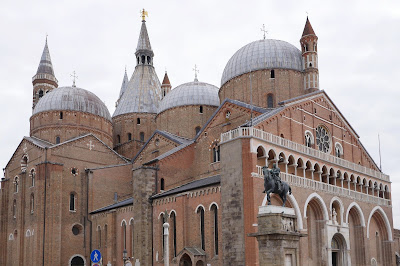Our first view of Cittadella
We are on our way to Verona airport for the flight home, but we have spotted the opportunity to stop off on the way at the wonderful walled town of Cittadella, about 30 km north of Padua and midway between Castelfranco del Veneto and Vicenza.
We drive north and soon reach the centre of Cittadella, appropriately at the Porta Padova (Padua Gate). We were enormously impressed by the wonderful walls of Montagnana, but in many ways the walls of Cittadella are more impressive - they are certainly higher.
Cittadella was founded in 1220 as a fortified castle, designed to act as outpost of Padua in the Veneto, with the intention of protecting its borders from assault by Treviso and Vicenza. Nowadays. Cittadella is a town of 20,000 inhabitants - most outside the walls.
We decided to start by walking round the outside of the walls, to get a proper sense of them, They are basically oval, 1461m in circumference with four gates more or less on the cardinal points. This first section, anti-clockwise from the Porta Padova features a rather incongruous modern section.
We soon arrive at the Porta Treviso, with a substantial barbican.
The next section of walls is equally imposing and my photo features the moat which is fed by spring water and encircles the walls. It was once twice as deep and twice as wide as it is now and as well as being part of the defences it was a useful source of fish.
At the third gate, Porta Bassano we spotted some people on the top of the walls and quickly discovered that this is the main point of entry
We climbed up to the Tourist Office and bought our tickets for the Parapet Walkway, which was only opened in 2013 after 20 years of extensive renovation work. It is just wonderful! This is our first view of the area inside the walls. The main feature is the Duomo, built between 1774 and 1826. You can also see one of the two main roads which connect opposite pairs of gates.
Looking out from the parapets we had a good view of this beautifully frescoed house, which we had noticed as we were on Porta Bassano.
The main focus however is the imposing line of walls seen from the inside.
It was also impressive to see how the walkway passes through a whole series of towers.
This was the final quadrant, between the Vicenza and Padova gates. We were interested to notice the hills in the background.
We carried on around the full circuit (you can bail out at Porta Padova) and returned to ground level after a truly wonderful walk around the walls. We walked towards Porta Padova and at the central crossroads admired the inside view of Porta Treviso. There wasn't much to be said about the Duomo.
We headed onwards towards the Porta Padova, along a very quiet street ...
... enlivened at the end by this jolly statue.
Conditions: a bit grey.
Rating: 5 stars.
Note: According to the very helpful leaflet about the walls, other nearby walled towns include Bassano del Grappa, Marostica, Asolo and Castelfranco Veneto. We have been to Castelfranco, and indeed stayed there, but the others might form the basis of another trip!
























































